Polar Vortex Car Tips

 Winter Car Tips from AutoPartsWarehouse.com
Winter Car Tips from AutoPartsWarehouse.com
Whether you are a seasoned DIY-er or a novice, these tips will help you get your car ready for severe winter weather. The AutoPartsWarehouse.com experts recommend you consult your owner’s manual before tackling any of these projects.
1. Winter Tires / Snow Chains / Snow Cables – Whether a vehicle is front wheel drive, rear wheel drive, or all-wheel drive, preparing tires for tough winter weather is a must. For temperatures consistently below 45 degrees, and in environments with ice, snow, and slush, regular all-weather tires just won’t cut it. Winter tires are specifically designed with unique tread patterns and of special compounds to improve traction and braking response in wet and snowy conditions. Since they are designed for cold weather conditions, snow tires are best removed as conditions improve. Most snow tire users keep a second set of wheels and tires in the garage so swapping is easy. For a climate more like Southern California, having a set of snow chains or cables on hand is critical for trips where there might be snow on the highway. In rough weather conditions, highway patrol or DOT regularly restrict driving without snow tires, or chains / cables. Most chains or cables have a maximum safe speed and can damage the car or chains/cables if the speed is exceeded. If you haven’t installed chains or cables before, do a test install in the driveway or garage before heading out.
2. Mud Flaps – Flaps offer a simple way to keep rocks and grit off the paint. Many mud flaps install in minutes using simple hand tools, and require no cutting or drilling.
3. Auxiliary Lighting – For the avid skier and snowboarder, getting up in the dark and long drives to the slopes are routine. Packing up the car can be greatly simplified with some extra lighting. Lighting can be installed in many different positions on the front of a vehicle including existing fog light openings in the bumper or grill, or via an accessory light bar. Many auxiliary lights include factory style connectors, relays and switches to make installation easy and clean.
4. Floor & Cargo Mats – Mats inside and in the cargo area are an easy way to protect the vehicle interiors from mud, muck, and snow, and need no installation. Having a special “winter set” in a darker color is a good idea.
5. Trailer Hitch, Roof Mounted Rack or Basket – Utilizing a roof rack, trailer hitch, or mounted basket to stow bulky skis, snowboards, coolers, etc. helps keep car interiors clean, maximizes hauling capacity and can also ensure safer driving by eliminating blind spots caused by blocked rear window views. If the vehicle has an existing hitch or rack rails, mounting should be easy. If the vehicle doesn’t have a hitch or rack, adding one can be a simple bolt-on or clamp-on project. Most vehicles have mounting points designed into their chassis or frame for installing a hitch.
6. Windshield Wiper Blades – Windshield wipers need to be replaced about once every year. Installing wipers is probably one of the simplest pre-winter travel DIY projects. To prevent freezing, consumers should use windshield washer fluid instead of water.
7. Check the Antifreeze (coolant) – The engine cooling system should be filled with a 50/50 mixture of antifreeze and distilled water to prevent freezing and boiling over. Use an antifreeze tester (available at the local auto parts store) to test the mixture. To keep the cooling system operating at peak performance, the manufacturer’s recommendations for changing the antifreeze (flush and fill) should be followed.
8. Change the Engine Oil – Use the recommended oil viscosity range for winter. 5W-30 motor oil flows quicker in cold weather than 20W-50. Most vehicle manufacturers recommend 5W-30 oil for year round protection.
9. Wash and Wax – It is a good idea to get a good car wash and wax before heading north to protect paint from road salt. Car owners should wash their cars as soon as they return home to remove any lingering road salt or grit.
10. Emergency Kit – It is important to be prepared with an emergency kit on board – especially when driving in tough winter conditions. The kit should include road flares, jumper cables, an ice scraper, a small shovel, a bag of salt (in case the car gets stuck in the snow), emergency blankets, extra set of warm clothes, boots, and gloves, a flashlight, a fully charged cell phone, basic first aid supplies, any important medication, water, and nonperishable snacks.
In addition to keeping all the items that will ensure a comfortable ski or snowboarding trip, drivers should remember the golden rules for driving in cold weather: remove snow and ice from the vehicle before driving; accelerate slowly; reduce speed; allow for much greater distances when driving behind other vehicles; know the brakes (for older vehicles without ABS, continuously pump brake pedal, for new vehicles with ABS, hold brake firmly); take turns slowly; continuously scan for potential road hazards, and be aware of other drivers.
More About:Car Safety
